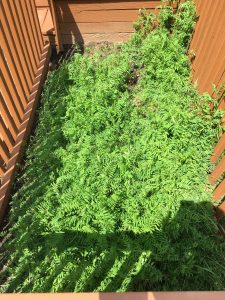In Extension, we often talk about integrated pest management, a way to control a pest from various angles. These angles are cultural, mechanical, and biological options for managing pests. A pest is simply something unwanted in a particular area. Pests could be plants, insects, or even mammals at times. The thought process is that there is no one perfect solution to a problem. Easy come easy go, some would say. I guess in this case it would be; easy go, easy come back!
A cultural way to break the cycle of many pests is to plan a crop rotation that involves crops from different plant families. Families in the sense of phylogenies or grouping according to similarities. For instance, the following plants: tomatoes, eggplants, peppers and even potatoes are all in the Solanaceae family. As you can tell, many of our garden crop favorites share a lot with one another.
One of the biggest mistakes in crop rotations is to rotate between unrelated plants/crops. This is important because pests can share similar crops and over winter in that specific crop residue. Take for instance the cucumber beetle; this pest will over winter on cucurbit residue and be ready to re-infect that crop, whether it is a cucumber, pumpkin or zucchini. This bug will also spread bacterial wilt that can cause a loss of an entire crop with a systemic infection.
The cucumber beetle will not damage tomatoes so planting a Solanaceae crop in an area that a Cucurbitaceae was growing would break that pest cycle. Pests can also be fungal. A fungus called Alternaria tomatophila causes early blight in tomatoes. The fungus can over winter in certain cultivars of potato and eggplant, both of which are in the Solanaceae family.
A good crop rotation starts with careful planning and can be successful by utilizing crops with complementary planting and harvest dates. A good rotation for May plantings would be to start with sweet corn (Poaceae). Sweet corn can be harvested around August and into September. A crop rotation will prevent certain cutworms and corn borers from being problematic in a specific area. A good follow-up crop in that area would be garlic (Alliaceae) planted in September/October and harvested in July. Once July comes, planting a legume (Fabaceae) will help remediate the soil and get the soil ready for the following season, hairy vetch for instance.
There are many rotations that work well in a crop rotation system, utilizing soybeans for a food plot can also be done. Just remember to rotate crops that are unrelated and replenish the soil at times. This can be accomplished through the use of legumes or fertilizers. A rotation only needs to be more than one crop; two is good, but three is great! Get your garden plans in place and dig right in.

